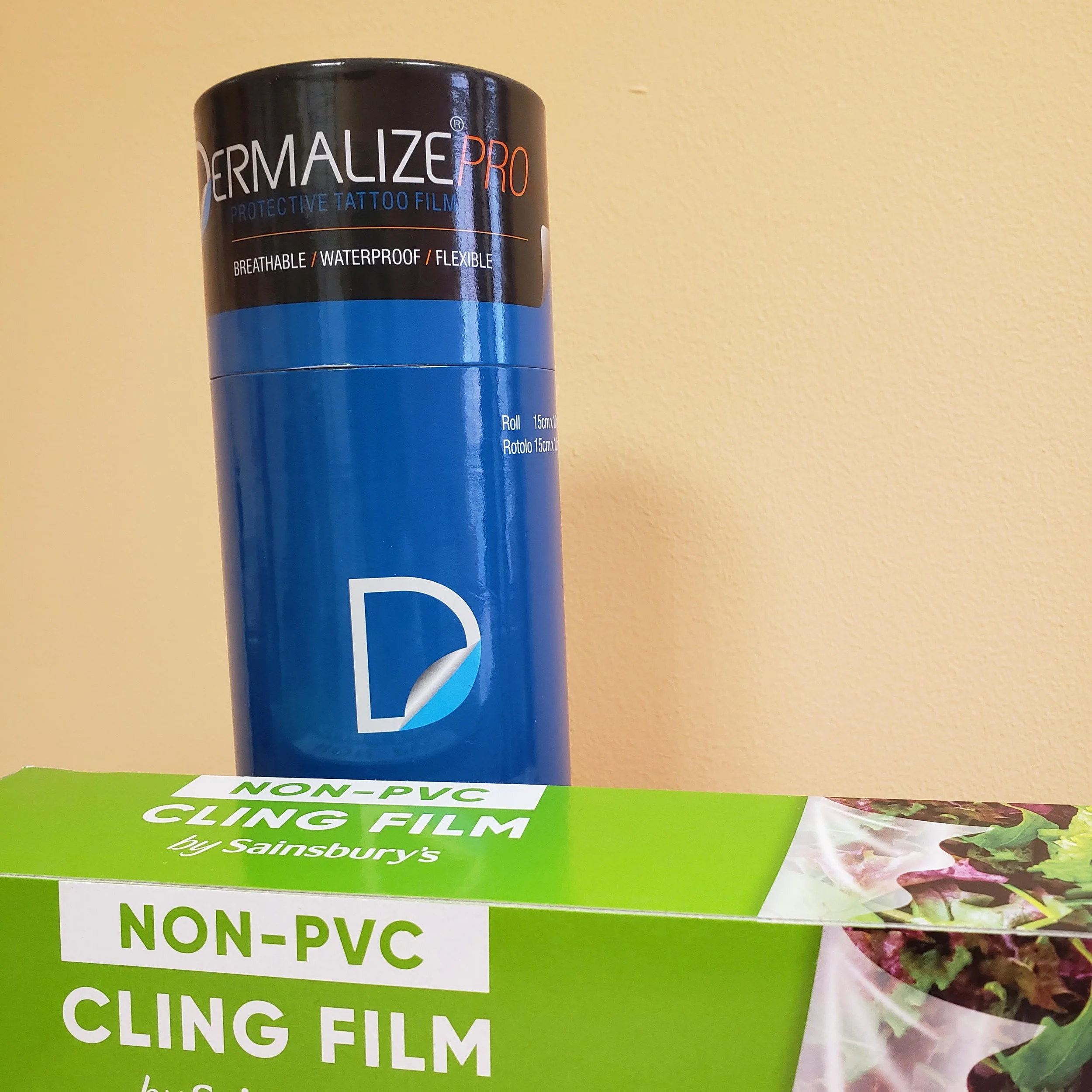
Tattoo Aftercare
So you've got your dope new tattoo, we've wrapped it up and you've made it safely home and are stood in the bathroom with soap in hand eager to unpeel and reveal. But now what? What's the best way to care for your new tattoo?
Aftercare breaks down into three easy stages; initial healing, The Itchy Scabby Stage, and lifetime care. Have a read through to see what we recommend for your new art. And remember, aftercare is for life, not just for the day or so after your tattoo.

Clingfilm vs Second Skin
First up is to check what your artist has used to wrap your new tattoo. We will use either clingfilm and micropore tape, or Dermalize (second skin) - a thin, transparent sheet which sticks directly to your skin and the tattoo. Which one we use after your appointment will depend on a number of factors including placement, size, allergies, skin sensitivities, and most importantly your own personal preference.
If we've used clingfilm, we recommend keeping it on for a minimum of 3 hours, then removing it once you are home or in a clean, safe environment. Remember that your clingfilm wrap is biological waste, so please dispose of it carefully and safely.
If we’ve used Dermalize, we recommend keeping it on for 24 hours. After this point, you can either remove it and continue with the aftercare instructions as detailed below, or gently clean the tattoo and replace it with a second piece (we can give you one to take home, or pop back and see us for a fresh one. You can also purchase your own online). If you choose to put a second piece on, we recommend leaving it for 3 to 5 days, then continuing with moisturising and lifetime aftercare as needed.

Initial Healing & The Itchy Scabby Stage
Once you've removed your bandage, gently clean your tattoo with a mild soap (no scents or perfumes) and pat dry. There will be a build-up of blood, plasma and ink under the wrap - this is completely normal, just a bit gross. Your tattoo may also feel warm to the touch and the skin around it may look red. At this stage, this is also completely normal, as your body pushes white blood cells to the area to begin the healing.
The most important thing to remember when cleaning your tattoo is that at this stage, it is an open wound. Take precautions such as washing your hands before touching it, using a clean unshared towel to pat dry, and avoiding harsh or heavy products in the area.
Continue to cleanse your tattoo in this way for the first 2 to 3 days. We recommend cleaning it twice a day - morning and evening - for ease of routine.
After 2 to 3 days, your tattoo will begin to dry out, scab up, and itch. This is completely normal, and is your body replacing the top layer of skin cells that were damaged during the tattooing process. At this point you can begin using your chosen aftercare balm after each cleansing. Use a sparing amount; just enough to lightly moisturise the tattoo (it should all soak into your skin without leaving a residue). You can also use it between cleansings if your tattoo is particularly itchy or dry. Cold packs, loose soft clothing, and gently slapping the tattoo can provide relief from the itch - but don't scratch it! Scratching can pull scabs off too early, causing scarring and ink drop-outs.
Thankfully, this itchy stage only lasts for a couple of days. Once all the scabs have naturally fallen or washed off - generally after around 2 weeks - your tattoo is considered healed and you can begin treating it as ‘normal skin’ again. It will still however appear shiny and the new skin may feel sensitive for up to another 2 weeks or so as the tattoo fully settles.
Tattoos are considered fully healed after around 4 weeks/one month. At this point, you can contact us if you notice any touch-ups that are needed.

Lifetime Aftercare
Congrats! Your tattoo is healed and you can treat it as such - it's now safe to shave over it, go swimming, fall off a bike, etc. But there's a few things you can do to ensure your tattoo stays looking bright, fresh and badass for a lifetime.
Use a high factor spf suncream (you should be doing this anyway, but especially on tattoos) when exposed to direct sunlight. UV light is a killer for tattoos, particularly colour ones, so stay protected.
Avoid using tanning beds. Again, UV light can fade tattoos even after they’ve been healed for years.
Keep up a good skincare routine. Continue regular moisturising to keep the skin supple and hydrated, and your tattoos glowing.
